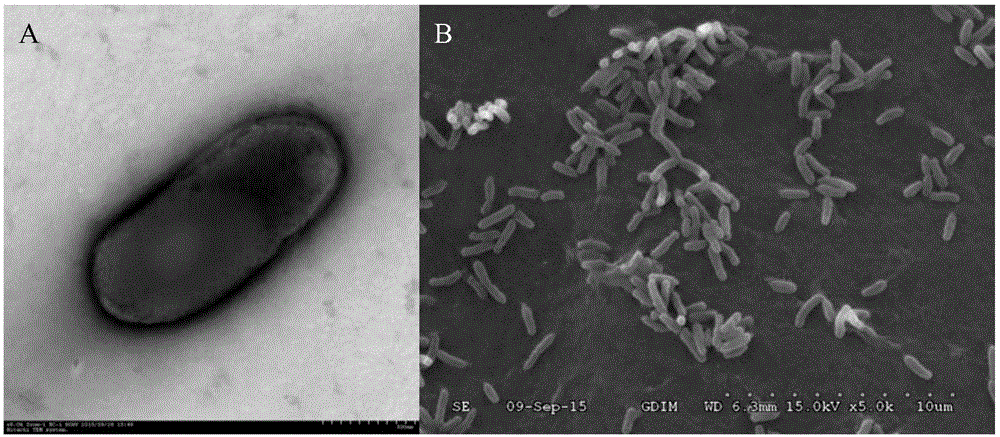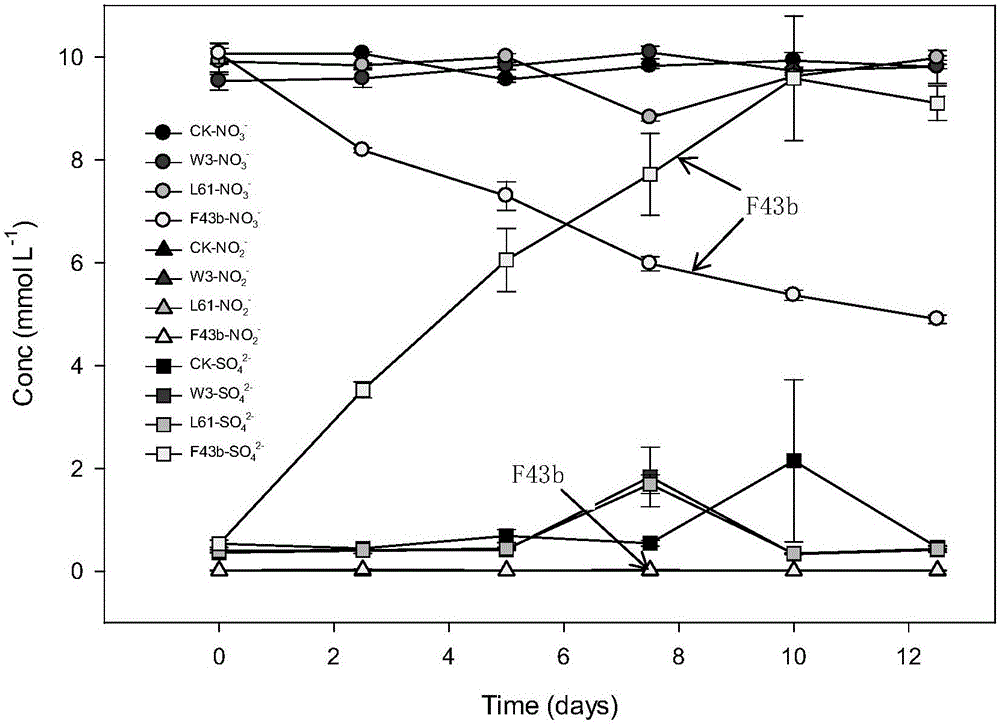Facultatively autotrophic sulfur oxidation denitrification rhizobium F43b and application thereof
A rhizobia and sulfide technology, applied in the field of microorganisms, can solve the problems of no sulfur oxidation and denitrification
- Summary
- Abstract
- Description
- Claims
- Application Information
AI Technical Summary
Problems solved by technology
Method used
Image
Examples
Embodiment 1
[0017] Example 1: Rhizobium sp. F43b T separation and identification of
[0018] Take a sample of 10g of river bed sediment in an electronic waste treatment area in Ronggui, Shunde, Guangdong Province, remove residues and large particles, wash with sterile water and centrifuge three times, collect it into a sterilized 120mL headspace bottle, add 100mL enrichment Medium (NH 4 Cl0.5g, MgCl 2 ·6H 2 O 0.5g, KH 2 PO 4 2g, Na 2 S 2 o 3 ·5H 2 O 2g, KNO 3 2g, NaHCO 3 1g, FeSO 4 ·7H 2 O0.1g, 1000mL deionized water, natural pH, autoclave at 121°C for 20min; among them, NaHCO 3 Filter sterilized, MgCl 2 ·6H 2 O. KH 2 PO 4 and FeSO4·7H 2 O Separately configure the mother liquor for sterilization, add it according to the concentration requirements after cooling; add 20g / L agar to the solid medium), press the cap of the headspace bottle, and culture it statically in an anaerobic box at 30°C. One month later, the culture was shaken, and 20 mL of the culture was centrifu...
Embodiment 2
[0024] Example 2: Rhizobium sp. F43b T Sulfur oxidation and denitrification under anaerobic and autotrophic conditions
[0025] Rhizobium sp. F43b T and type strain Rhizobium rosettiformans W3 T and Rhizobium daejeonense L61 T Activate on the rhizobia medium, take a certain amount of bacteria and wash it three times with the sterilized enrichment medium, respectively take 100μL of the bacterial solution with a protein concentration of about 100μg / mL and inoculate it into the sterilized culture medium containing 100mL In the 120mL headspace bottle of base, wherein, the culture medium of this embodiment is the KNO of enrichment medium of embodiment 1 3 The concentration was adjusted to 1g / L, and the other components of the medium remained unchanged. Three replicates were set for each strain, and three blank control groups without inoculation were set. . The culture was shaken once every 12 hours, and samples were taken at 0 days, 2.5 days, 5 days, 7.5 days, 10 days and 12.5...
Embodiment 3
[0027] Example 3: Rhizobium sp. F43b T Sulfur oxidation and denitrification function under organic anaerobic conditions
[0028] Rhizobium sp. F43b T (i.e. strain F43b T ) and type strain Rhizobium rosetiformans W3 T and Rhizobium daejeonense L61 T Activate on the rhizobia culture medium, take a certain amount of bacteria and wash with sterile water three times, take 100 μL of the bacterial solution with a protein concentration of about 100 μg / mL and inoculate it into 120 mL headspace containing 100 mL of medium that has been sterilized In the bottle, design three processing, the medium of processing 1 is to add Na simultaneously in the enrichment medium of embodiment 1 2 S 2 o 3 ·5H 2 O 1g / L and NaAc·3H 2 O 1g / L is used as electron donor, and the culture medium of processing 2 is to add NaAc·3H separately in the enrichment medium of embodiment 1 2 O 1g / L is made electron donor, and the substratum of processing 3 is to add Na simultaneously in the enrichment substratu...
PUM
| Property | Measurement | Unit |
|---|---|---|
| diameter | aaaaa | aaaaa |
Abstract
Description
Claims
Application Information
 Login to View More
Login to View More - R&D
- Intellectual Property
- Life Sciences
- Materials
- Tech Scout
- Unparalleled Data Quality
- Higher Quality Content
- 60% Fewer Hallucinations
Browse by: Latest US Patents, China's latest patents, Technical Efficacy Thesaurus, Application Domain, Technology Topic, Popular Technical Reports.
© 2025 PatSnap. All rights reserved.Legal|Privacy policy|Modern Slavery Act Transparency Statement|Sitemap|About US| Contact US: help@patsnap.com



